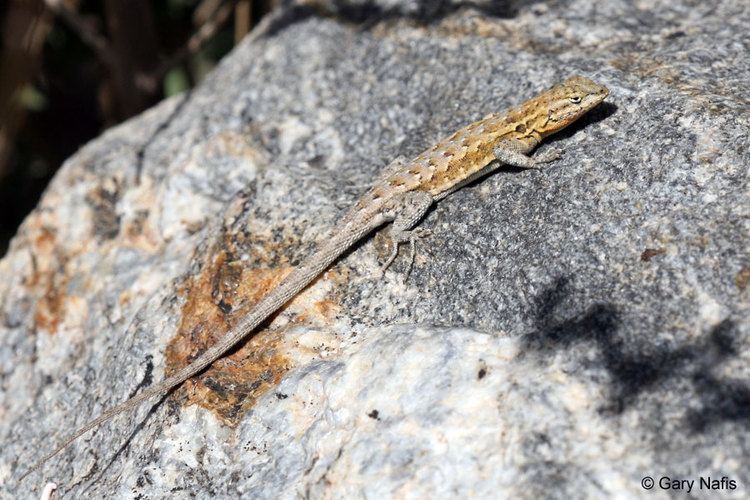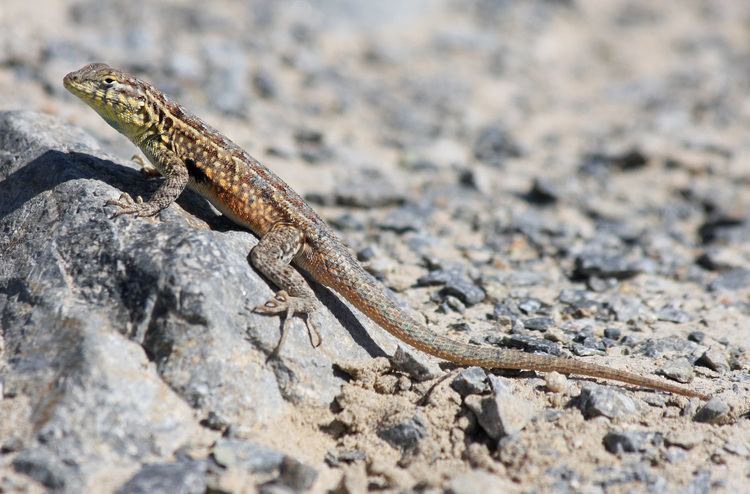Suborder Lacertilia Family Phrynosomatidae Phylum Chordata Rank Genus | Subphylum Vertebrata Infraorder Iguania Scientific name Uta Higher classification Phrynosomatinae Order Scaled reptiles | |
 | ||
Similar Common side‑blotched lizard, Reptile, Zebra‑tailed lizard, Western whiptail, Urosaurus | ||
Side blotched lizards play rock paper scissors
Side-blotched lizards are lizards of the genus Uta. They are some of the most abundant and commonly observed lizards in the deserts of western North America. Their cycle among three colorized breeding patterns has achieved notoriety and is best described in the common side-blotched lizard. They commonly grow to six inches including the tail, with the males normally being the larger sex. Males often have bright throat colors.
Contents
- Side blotched lizards play rock paper scissors
- Lizards of az common side blotched lizard uta stansburiana
- SEX
- Systematics
- References

These lizards are prey for many desert species. Snakes, larger lizards, and birds all make formidable predators to side-blotched lizards. Larger lizard species, such as collared, leopard, and spiny lizards, and roadrunners are the main predators. In turn, the side-blotched lizards eat arthropods, such as insects, spiders, and occasionally scorpions.

As a result of their high predation rate, these lizards are very prolific breeders. From April to June they breed, with the young emerging as early as late May. These inch-long young appear all through the summer, and into September.

The diploid chromosome number in most if not all species is 34, consisting of 12 macro- and 22 microchromosomes.

Lizards of az common side blotched lizard uta stansburiana
SEX

Side-blotched lizards are notable for having the highest number of distinct male and female morphs or "genders" within a species: three male and two female.

Orange-throated males are "ultra-dominant, high testosterone", who establish large territories and control multiple females. Yellow stripe-throated males ("sneakers") do not defend territory at all, but cluster on the fringes of orange-throated lizard territories, and mate with their females while the orange-throat is absent, as the territory to defend is large. Blue-throated males are less aggressive and guard only one female; they can fend off the yellow stripe-throated males but cannot withstand attacks by orange-throated males. Orange-throated females lay many small eggs and are very territorial. Yellow-throated females lay fewer, larger eggs, and are more tolerant of each other.
The orange and blue-throated males will even boldly approach a human intruder, to give his female(s) a chance to escape. When she is safe, he will join her in a hole, or under a rock.
This is called the rock paper scissors effect as like the playground game the outcome of the mating success shows that one morph of the lizard takes advantage over another but not over the third.
Systematics
The systematics and phylogeny of the side-blotched lizards is very confusing, with many local forms and morphs having been described as full species. Following the 1997 review of Upton & Murphy which included new data from mtDNA cytochrome b and ATPase 6 sequences, the following species can be recognized pending further research:
Uta stellata and U. concinna are now usually considered subspecies of U. stansburiana. U. encantadae, U. lowei, and U. tumidarostra might be subspecies of a distinct species (Las Encantadas side-blotched lizard), instead. Similarly, U. auriculata and U. clarionensis might be subspecies of a single species, the Revillagigedo side-blotched lizard.
